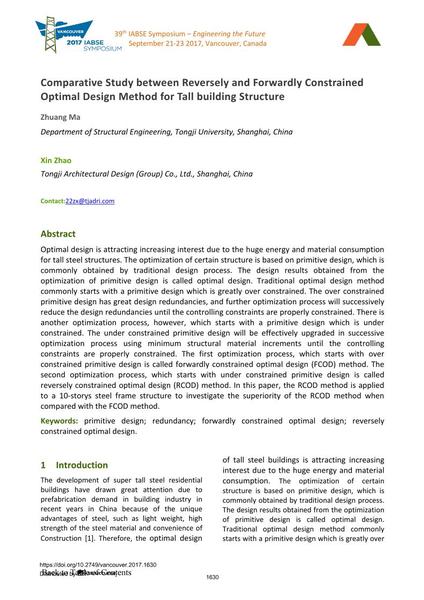Comparative Study between Reversely and Forwardly Constrained Optimal Design Method for Tall building Structure

|
|
|||||||||||
Bibliographic Details
| Author(s): |
Zhuang Ma
(Department of Structural Engineering, Tongji University, Shanghai, China)
Xin Zhao (Tongji Architectural Design (Group) Co., Ltd., Shanghai, China) |
||||
|---|---|---|---|---|---|
| Medium: | conference paper | ||||
| Language(s): | English | ||||
| Conference: | IABSE Symposium: Engineering the Future, Vancouver, Canada, 21-23 September 2017 | ||||
| Published in: | IABSE Symposium Vancouver 2017 | ||||
|
|||||
| Page(s): | 1630-1635 | ||||
| Total no. of pages: | 6 | ||||
| Year: | 2017 | ||||
| DOI: | 10.2749/vancouver.2017.1630 | ||||
| Abstract: |
Optimal design is attracting increasing interest due to the huge energy and material consumption for tall steel structures. The optimization of certain structure is based on primitive design, which is commonly obtained by traditional design process. The design results obtained from the optimization of primitive design is called optimal design. Traditional optimal design method commonly starts with a primitive design which is greatly over constrained. The over constrained primitive design has great design redundancies, and further optimization process will successively reduce the design redundancies until the controlling constraints are properly constrained. There is another optimization process, however, which starts with a primitive design which is under constrained. The under constrained primitive design will be effectively upgraded in successive optimization process using minimum structural material increments until the controlling constraints are properly constrained. The first optimization process, which starts with over constrained primitive design is called forwardly constrained optimal design (FCOD) method. The second optimization process, which starts with under constrained primitive design is called reversely constrained optimal design (RCOD) method. In this paper, the RCOD method is applied to a 10-storys steel frame structure to investigate the superiority of the RCOD method when compared with the FCOD method. |
||||
| Keywords: |
redundancy primitive design forwardly constrained optimal design reversely constrained optimal design
|
||||
